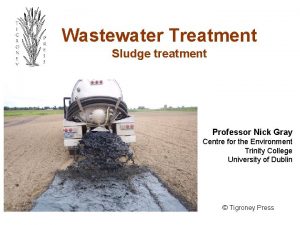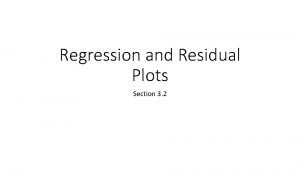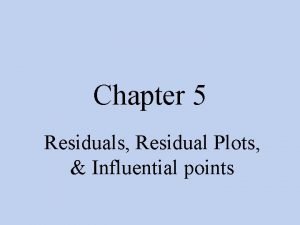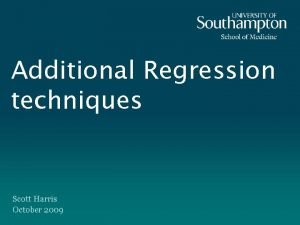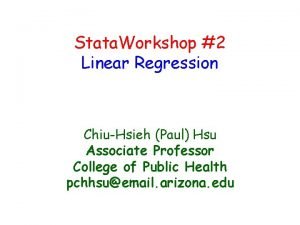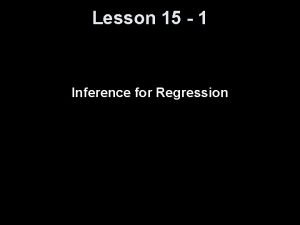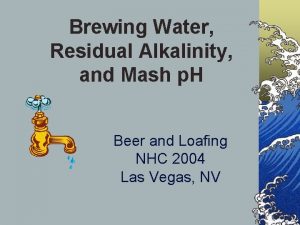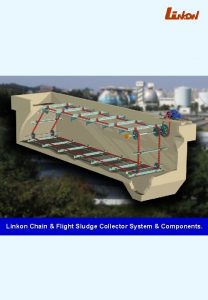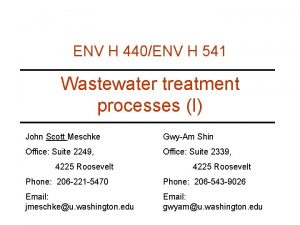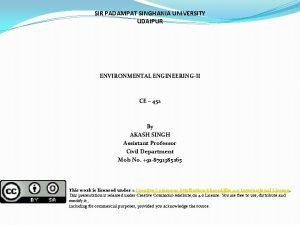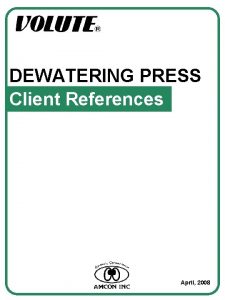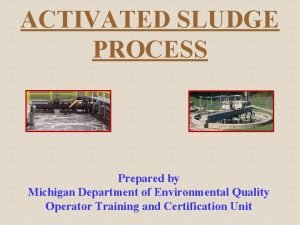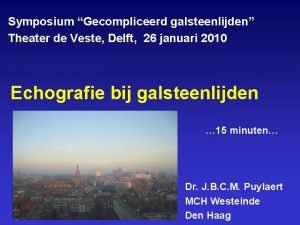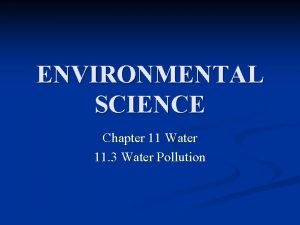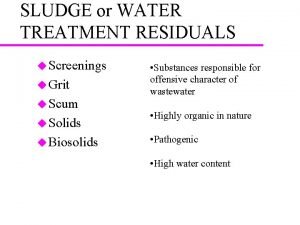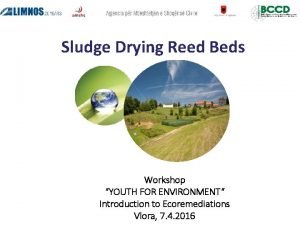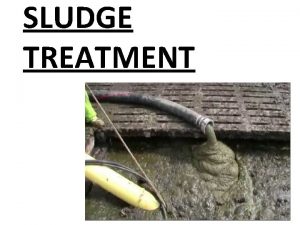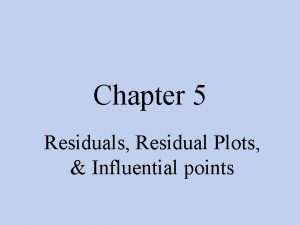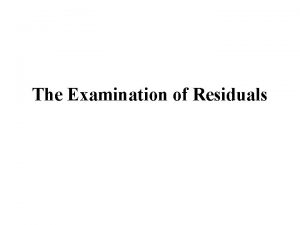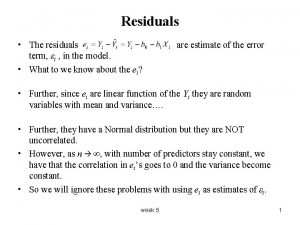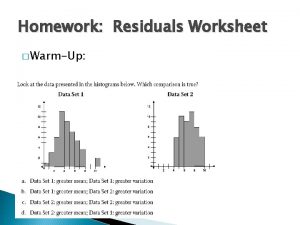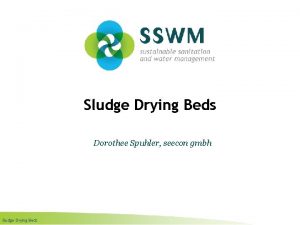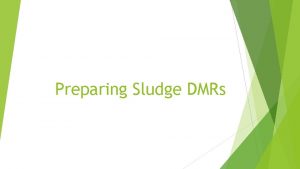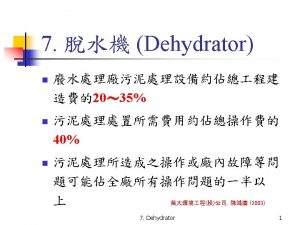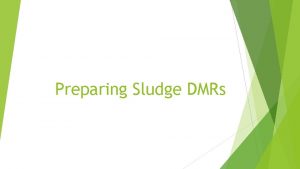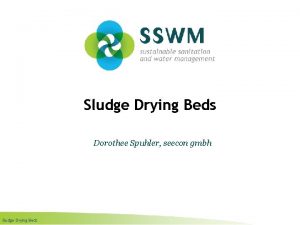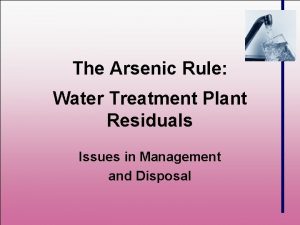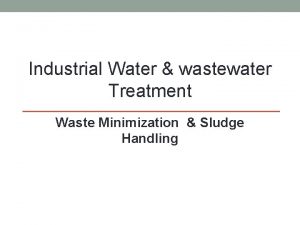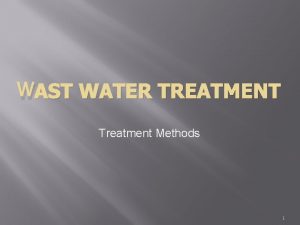SLUDGE or WATER TREATMENT RESIDUALS u Screenings u




















- Slides: 20

SLUDGE or WATER TREATMENT RESIDUALS u Screenings u Grit u Scum u Solids u Biosolids • Substances responsible for offensive character of wastewater • Highly organic in nature • Pathogenic • High water content Reduce water content, organic content and render solids suitable for reuse or final disposal

Sludge Management and Disposal u Thickening, Conditioning – gravity, flotation u Dewatering, Drying Reduce volume by reducing water content – Vacuum filtration, centrifugation, pressure filtration u Digestion, Composting, Stabilization – aerobic, anaerobic, alkaline treatment Reduce organic content/pathogens u Disposal – land application, burial, incineration FINAL DISPOSAL

REGULATIONS u 40 CFR 503 – Uses BIOSOLIDS instead of Sludge when put into beneficial reuse – Land application of biosolids (Class A and Class B) – Surface disposal – Pathogen and vector reduction – Incineration

Volume Mass Relationships Specific Gravity and Volume of Solids Specific gravity of solids Vs = Ws/Ss*ƿ

Volume Mass Relationships Specific Gravity and Volume of Sludge Specific gravity of solids

THICKENING u Increase the solids content of sludge by removing a portion of the liquid fraction u Activated sludge 0. 8% to 4% results in fivefold decrease in sludge volume u Settling, flotation, centrifugation, gravity belt, rotary drum

Sludge Dewatering u Sludge drying beds – historically the most common – sand bed, 15 -30 days, evaporation & seepage u Vacuum Filtration – cylindrical rotating drum covered with fabric – submerged with applied vacuum u Continuous belt filter presses (follows) u Plate pressure filters – vertical plates mounted on a frame

Belt Filter Press: Description In the belt press process, chemical conditioned sludge is resting on a gravity drainage section so that it can be thicken. Water is able to fall from the sludge by the force of gravity. Now pressure is being applied in a low pressure section, where the sludge is squeezed between opposing porous cloth belts. Next it will travel through a high pressure section, where the sludge is subjected to a shear force as the belts pass through a series of rollers. This shearing force and squeezing process reduces additional quantities of water from the sludge. Finally dewatered sludge cake is removed from the belts by scraper blades.

Belt Filter Press

Sludge Volume Reduction A. Start with 1 liter of 1% by weight (i. e. , 10 g/L) sludge. Mass of sludge = (1 liter)(1000 g/L) = 1000 g sludge Mass of solids = (1 liter)(10 g/L) = 10 g dry sludge solids Mass of water = 1000 g - 10 g = 990 g H 2 O B. Gravity Thicken to 4% dry solids (i. e. , 40 g/L). Mass of sludge = (10 g)/(0. 04) = 250 g sludge Mass of solids = unchanged = 10 g dry sludge solids Volume Removed = (1000 m. L - 250 m. L)/1000 m. L = 75% Mass of water = 250 g - 10 g =240 g H 2 O C. Vacuum Filter to 30% dry solids (i. e. , 300 g/L). Mass of sludge = (10 g)/(0. 30) = 33. 3 g sludge Mass of solids = unchanged = 10 g dry sludge solids Volume Removed = (1000 m. L - 33. 3 m. L)/1000 m. L = 96. 7% Mass of water = 33. 3 g - 10 g = 23. 3 g H 2 O

MASS BALANCE for Thickening V 1 = P 1 V 2 P 2 V = volume of sludge P = percent solids in sludge

Anaerobic Digestor 12 -20 days of aeration ~50% reduction in solids

Digester

Anaerobic Digestion • Sludge held without aeration for 10 -90 days • Process can be accelerated by heating to 35 -40 o. C • These are called High Rate Digestors (10 -20 days) • Advantages • low solids production • useable methane gas produced • Disadvantages • high capital costs • susceptibility to shocks and overloads

Conventional standard rate single-stage High rate Completely mixed single-stage Two-stage Process

Process Microbiology Lipids, Proteins, Nucleic Acids, Polysaccharides Hydrolysis Fatty Acids, Amino Acids, Monosaccharides etc Acidogenesis Acid formers Alcohols, hydrogen, CO 2, formate, acetate Methane and Carbon Dioxide Methanogenesis Methane formers

Process Microbiology Methanogens or Methane Formers 4 H 2 + CO 2 = CH 4 + 2 H 2 O 4 HCOOH =CH 4 + 2 H 2 O + 3 CO 2 CH 3 COOH = CH 4 + CO 2 CH 3 OH = 3 CH 4 + CO 2 + 2 H 2 O 4(CH 3)3 N + H 2 O = 9 CH 4 +3 CO 2 + 6 H 2 O+ 4 NH 3 p. H 6. 6 -7. 6, alkalinity should be present; slow growth rates Y =0. 06

Digester Design u Mean Cell Residence Time u Volumetric Loading Factor u Observed Volume Reduction u Loading Factors Based on Populations

Toxics in Municipal Sludge Problem with buildup of heavy metals in soil receiving sludge

Ultimate Sludge Disposal
 Sludge treatment
Sludge treatment Water and water and water water
Water and water and water water How to find standard deviation of residuals
How to find standard deviation of residuals Section 10 topic 5 residuals and residual plots
Section 10 topic 5 residuals and residual plots Participations and residuals
Participations and residuals Schoenfeld residuals spss
Schoenfeld residuals spss Studentized residuals stata
Studentized residuals stata Lesson 15 interpreting residuals from a line
Lesson 15 interpreting residuals from a line What is residual alkalinity
What is residual alkalinity Activated sludge process flow chart
Activated sludge process flow chart Flight sludge collector
Flight sludge collector Sludge dumbbells
Sludge dumbbells Secondary wastewater treatment
Secondary wastewater treatment Activated sludge process
Activated sludge process Sludge press
Sludge press Epesár
Epesár Sludge density index formula
Sludge density index formula Hydrops galblaas
Hydrops galblaas Wastewater sludge
Wastewater sludge Sludge drying beds
Sludge drying beds Ekoremediacije
Ekoremediacije
